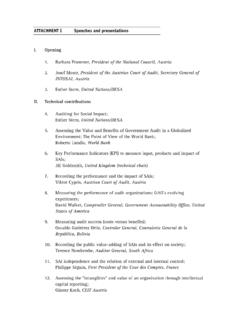Transcription of Public Private Partnerships in Vocational Education …
1 1 Public Private Partnerships in Vocational Education and Training: International Examples and Models Josh Hawley, Consultant to World Bank and Ohio State University USA Introduction As Kazakhstan faces making investments in their extensive Vocational Education and training system, there are important forces driving the Vocational Education and training system in Kazakhstan to bring employers more actively into the educational process. The first reason to engage employers is to improve system level governance, to engage social partners in planning for Vocational Education and training.
2 The second reason is fiscal. The government is interested in sharing the cost of Vocational Education and training with employers. Thirdly, there is a sense among local educators that the quality of the Education will be improved by employer involvement in curriculum and testing, particularly in the development of the educational standards or a national qualifications framework. Finally, although it is undocumented, there remains a need to engage employers at the local level in the teaching and learning process. This last reason is perhaps the most critical from the international literature, although the hardest to mandate through national level policy and investment.
3 The following memo provides some introduction to the issue of social Partnerships or employer involvement in Vocational Education and training, and describes the existing situation in some key countries globally. 2 Social Partnerships in VET Public - Private Partnerships , or social Partnerships , are critical to the development of high quality Vocational Education and training because they allow for regular communication between employers and VET providers. This generation of better networks for communication is a tangible outcome of social partnership activities.
4 Communication is critical in VET practice on many levels. This communication enables VET providers to learn what skills are in demand and to train for jobs that change regularly. The communication also allows employers to have input into the curriculum of VET and often gives them a recruiting tool to attract skilled workers. In systems such as those in Australia, New Zealand, or South Korea by developing a national qualifications framework and accountability system they have encouraged the development of communication. Therefore, communication is both a critical part of good social Partnerships and an outcome of consistent engagement between the Public and Private sectors(Grubb & Lazerson, 2004).
5 In a market economy, Public Private Partnerships are the glue that links Education and employers. The term is really used as shorthand for a range of Public policies, funding systems, and curriculum frameworks that have as a shared goal to tighten the level of communication among educators and employers. The policy framework that governs these Partnerships is varied, although there are archetypical systems. Germany s dual system is one model of Public Private engagement. The German system is based on a law from 1969 that mandates a particular governance structure for Vocational Education and training.
6 At the heart of the German system is a delegation of responsibility for curriculum and assessment to a coalition of labor representatives, 3businesses, and educators. The business associations play a particularly complex role, managing the system by monitoring the quality of training provided by firms in the dual system (Brand, 1998; Gill & Dar, 2000; Rauner, 1998). Studies of the German model lay out the following as key components that need to be in place: 1. A legislative framework that requires firms to invest in training of newly hired workers; 2.
7 A funding mechanism through a combination of federal, regional, and business spending; 3. The capacity to carry out job analysis and curriculum development; 4. Local institutions that represent the interests of businesses; and 5. Trained professional instructors and administrators. The German model has proven difficult to replicate internationally. Some countries, such as Thailand or Korea, have managed to put into place a small number of dual system places (Gill & Dar, 2000). However, even the former Eastern Germany has had challenges in extending the dual system.
8 Culpepper s book (2003) is a detailed examination of the reasons that the dual system can and can t be expanded within Europe. There are several lessons, most importantly that unless companies see participation in their best interests they will not participate in and ultimately pay for training and hiring of Vocational Education graduates. The reality is that as labor markets are liberalized, and the cost of doing business in Germany itself has increased relative to other manufacturing intensive countries like China, the dual system has become less important as a critical part of the VET structure.
9 The need to lower labor costs and 4maintain flexibility in the hiring and assignment of labor among nations means that firms are less interested in participating in a dual system (Culpepper, 2003). A second model for Private involvement in Vocational Education and training is Japan, which maintains a model completely different from that used by Germany, but one that is relevant in the US and other nations with strong social networks (Kariya & Rosenbaum, 2003; Rosenbaum, 2002). Historically, labor for Japan s manufacturing system has come from high schools, which have a network of relationships with hiring managers that allow them to place their most accomplished students preferentially.
10 This system is based on a local relationship, and depends on high school staff correctly analyzing the skills of potential graduates and their fit with the academic and Vocational needs of employers. The Japanese system is similar to an extent to what happens in US Vocational schools, but only in those that are very high quality. In both cases, the high quality Vocational schools are built of strong relationships between educators and employers. A third model focuses on is encouraging firm level training through government policy. This is usually called a Human Resource Development or Workforce Development system.
















